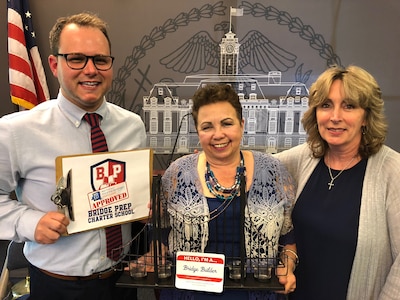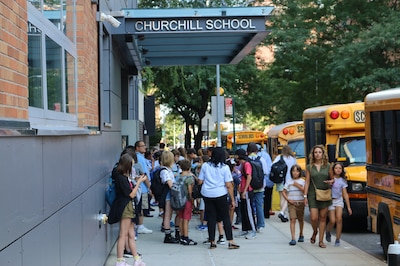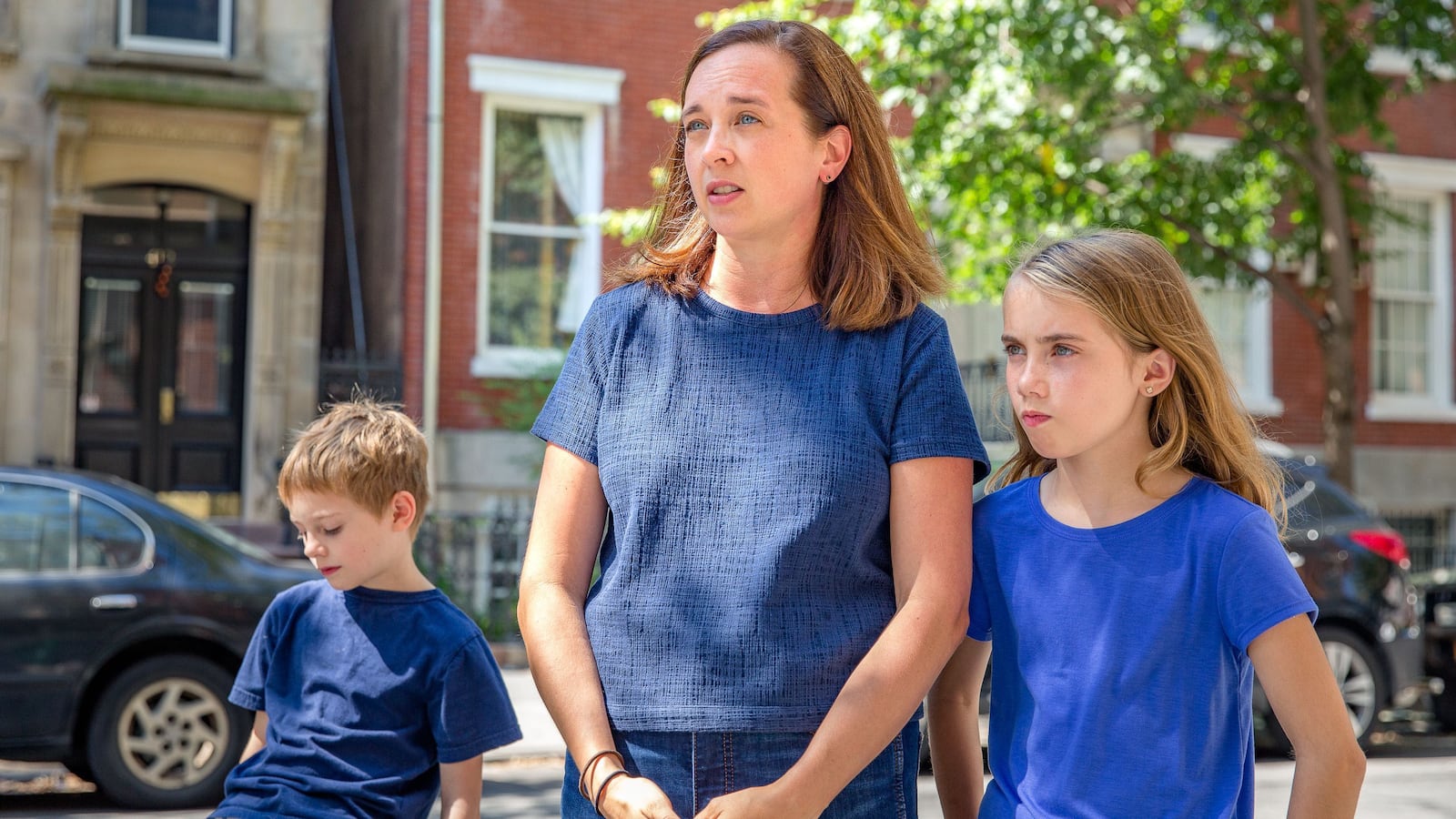This is part of an ongoing collaborative series between Chalkbeat and THE CITY investigating learning differences, special education, and other education challenges in NYC schools.
Some city parents were so desperate to get their dyslexic children the reading instruction they couldn’t find in the public school system that they rewrote the script by founding their own school.
Bridge Preparatory Charter School on Staten Island will open its doors to 90 first- and second-graders on Thursday, as the only public school in the state that caters to students with language-based learning disabilities such as dyslexia.
The school’s debut marks the climax of a yearslong battle for parents, advocates and elected officials eager to create an environment with small classes, intensive phonics-based instruction and other supports.
The charter school opens against the backdrop of a public school system that educators and experts contend has no systematic approach to teaching thousands of students with learning disabilities how to read, despite no shortage of methods proven to work.
Meanwhile, a growing number of students with disabilities are leaving public schools and winning hundreds of millions of dollars in private school tuition reimbursements from the city — fueled, in part, by parents determined to get their dyslexic children reading.
“These are parents who were really just asking for something so basic and so fundamental,” said Tim Castanza, Bridge Prep’s co-founder, executive director, and a former city Department of Education official. “Their kid learns differently — they were asking for just a program in a school to give their kid what they needed.”
Teachers at Bridge Prep will get ongoing training in a popular phonics-based, multi-sensory approach to reading instruction known as Orton-Gillingham. Students will be assigned no homework, a known stressor for children who struggle with reading.
Education officials say they offer a range of supports to boost literacy — including the addition of 500 classroom coaches over the past three years and 960 others primarily focused on small-group reading instruction.
But some advocates and politicians note those efforts aren’t specifically tailored toward kids with dyslexia. They argue the DOE should add significantly more phonics-based instruction and introduce mandatory learning-disability screenings in the early grades.
Tears of Frustration
Staten Island Borough President James Oddo, whose team took a lead role in founding the charter school, said his eyes were opened to the lack of options for children with dyslexia when he held meetings where parents would break down in tears.

For years, dozens of Staten Island kids with dyslexia endured a 1.5-hour yellow bus commute each way to one of the few nearby schools that could help them: The Community School in Teaneck, N.J.
“There are hundreds, thousands of kids on Staten Island — and certainly across the city — who still are going without this and who are hostage to an antiquated educational system that will not help them,” Oddo said. “We should fundamentally change the way we teach.”
More than 76,000 New York City students have learning disabilities, according to Department of Education data.
Dyslexia, characterized by a difficulty in processing language that impedes reading, is the most common learning disability. Some experts estimate the percentage of children on the dyslexia spectrum ranges from 10% to 20%, while others put the figure much lower.
But for years, public school officials refused to even allow the word “dyslexia” in education plans for students with disabilities, citing a technicality in federal law.
Instead, the more generic “learning disabilities” diagnosis was written. Advocates and elected officials said that made it harder for students with dyslexia to get the proper services in their individualized education program, a legally-binding document known as an IEP.
Schools only began using the dyslexia designation last year, after the state legislature passed a law. Still, city officials cannot say how many IEPs now include the word “dyslexia.”
Over the years, thousands of parents of dyslexic kids have argued their right to an appropriate public education was violated because schools couldn’t provide proper instruction — claims repeatedly confirmed by independent administrative hearing officers.
Through orders by hearing officers or settlements of claims, children have received private tutoring and other services outside the school day — paid for by the city Department of Education.
The DOE also foots the bill for hundreds of students with learning disabilities to attend expensive private schools each year. In just one example from last school year, the DOE shelled out $46.4 million for 750 students to attend four highly-sought schools in Manhattan known as havens for kids with learning and other disabilities.
But that legal process is notoriously laborious, and requires parents to hire a lawyer and usually pay tuition upfront in hopes of being reimbursed.
Imbalanced System Mired in ‘Crisis’
This system tends to benefit well-off parents who have the time and money to battle through the deluged impartial hearing system. The process, often full of stresses and financial strains, can end with the child traveling far from their neighborhood school.
Parents without the means to hire private tutors or sue the system can spend countless hours trying to convince school officials to provide needed services. Some might get part or even all they ask for, but others eventually give up, according to special education advocates.
Seeing this pattern repeated over and over led Assemblymember Robert Carroll (D-Brooklyn), who is dyslexic and attended private school at the DOE’s expense, to declare a “crisis.”
“I don’t know how this is not the biggest social justice issue facing the Department of Education right now,” he said. “The only kids who are dyslexic who are getting a good education are disproportionately upper class and white.”
For Juliet Gomez, who lives in public housing in Brooklyn’s East New York, it took getting a pro-bono lawyer to help her win a private school placement for her son Dimitri. In elementary school, Dimitri failed to write numbers correctly and spell words like “dog,” often reversing the order of the letters.
He grew increasingly frustrated, often faking stomach aches to stay home. Gomez sought out a lawyer at Advocates for Children who secured extra help for Dimitri from a special education teacher, although that instructor was not a trained reading specialist.
“They weren’t having any success,” Gomez said.
By fourth grade, Dimitri was two and a half years behind grade level, she said, and had been held back twice.
Eventually, Gomez’s lawyer was able to land Dimitri, who is now 13, at the private school Tiegerman on Long Island at the DOE’s expense. Dimitri is “making great progress,” his mother said.
Without the free legal help, Gomez said, “I don’t even think [Dimitri] would have a proper education because he would still be struggling with reading.”
‘No Consistency School-to-School’
Parents and advocates say issues with helping dyslexic students run deep.
Teacher preparation programs aren’t consistently instructing educators on how to best teach children to read, experts said. Most public schools don’t have teachers with extensive training in methods such as Orton-Gillingham — and those that do have them are in short supply.
Principals also have leeway to choose a reading curriculum with little oversight by the education department, which doesn’t track the programs schools use. Schools Chancellor Richard Carranza has suggested there should be more coherence in the city’s literacy efforts, but there’s been little movement.
Some experts say this patchwork of programs and lack of a guiding literacy strategy lead to a wide range of students falling behind.
Results on the state’s annual reading exam in 2019 show a wide gulf remains between students with special needs and their general education peers. Just 16.1% of students with disabilities were proficient in reading in grades 3 to 8, compared with 56.2% of general education students, the data show.
“One of the problems in New York is there is no consistency school-to-school. There is no consistent literacy person who is creating a strategy about literacy in this city and I think that is a tremendous problem,” said Susan Neuman, an NYU professor and literacy expert.
Neuman said she believes too little time is spent on phonics. “Like playing piano, you need your scales first,” she added.
Even Strong Schools Struggle
The lack of support for students with learning disabilities is so widespread that even some of the best public schools in the city aren’t immune, parents and advocates say.
Laura Nest Wallace said special education teachers and a reading specialist at Public School 29 in Brooklyn’s Cobble Hill helped her daughter Madeleine get by amid challenges from mild dyslexia. But when it came to her son Max, who fell far behind in second grade, the staff members essentially told Wallace they wouldn’t be able to help him.
The school didn’t respond to requests for comment.
After discussions with the DOE, officials agreed to pay for his $59,000 tuition at The Churchill School in Manhattan. It’s a long commute for a 9-year-old by yellow bus. But Wallace said her son is making progress on his reading in the smaller classroom setting.

“I talked to so many parents in [Brooklyn’s] District 15, a lot of them at very coveted schools, and they sort of have had similar experiences, sometimes worse experiences,” she said.
“Even the really great schools seem to struggle with kids with dyslexia.”
A Problem Beyond New York
Across the country, the debate over how to teach reading is so intense it earned the moniker “the reading wars.” The city’s public schools system came down on one side of the argument in 2003 when then-schools Chancellor Joel Klein backed the so-called “balanced literacy” approach.
Balanced literacy advocates believe learning to read is a natural process, that enjoyment of reading is paramount, and that helping students understand the meaning of text is more important than teaching them the mechanics of reading.
But experts question whether it’s the best method for struggling readers.
The opposing approach, rooted in phonics-based instruction, emphasizes decoding how letters correspond to sound and how the sounds connect to form words. It can be dry and repetitive, but many experts say the method establishes a firm base that benefits a wide array of students.
Many students can learn to read through a balanced literacy approach, particularly when it’s complemented with additional reading and vocabulary work at home, the experts say. But for those who struggle — including those with dyslexia — balanced literacy can feel like being thrown into the deep end of a pool.
“Somehow or other, the public schools moved away from the idea that reading was a skill, and they moved to an idea in education that reading was exposure,” said Ruth Arberman, the founder and director of The Sterling School, a Brooklyn private school for students with learning disabilities.
“If you said, ‘I want to learn to drive a car,’ and I said to you ‘Fine, go watch the traffic on Atlantic Avenue for a while and then I’ll hand you the keys’ — you would laugh,” added Arberman. “And yet that is how we teach reading in public schools.”
Reading Coaches Added
Education department officials point to Mayor Bill de Blasio’s “universal literacy” effort, which has placed roughly 500 reading coaches across all elementary schools over the past three years.
In a joint effort with the United Federation of Teachers, education officials also redirected 960 IEP teachers to primarily focus on small-group instruction of students struggling to read. Two-thirds of those teachers are at elementary schools, and all have been trained in phonics-based reading practices, according to UFT officials.
Esther Friedman, who oversees the education department’s literacy efforts, said 13,500 teachers participated in training sessions last year — of which 40% were focused on phonics or “phonics-related topics.” She acknowledged that the DOE doesn’t mandate schools to use a particular approach, but the agency can encourage principals to adopt certain programs by subsidizing the cost of materials.
“Our task is to try to train as many people as possible,” Friedman said. Those trainings, she added, “are absolutely derived from the reading science.”
Officials said many teachers are trained in Orton-Gillingham approaches, though it was not clear how many.
Experts say these efforts, while welcome, fall far shy of where the system needs to be.
At the private Stephen Gaynor School in Manhattan, students get at least 45 minutes of small-group instruction with certified Orton-Gillingham teachers daily.
Head of school Scott Gaynor said public schools need more teachers trained in similar approaches, but noted the scale of the overhaul would require a firm commitment from state lawmakers and city leaders.
“I realize it’s not an easy lever to pull, that it requires a lot of time and resources and money, but working in a school that’s done this over 50 years, I see that it works,” he said.
Assemblymember Jo Anne Simon (D-Brooklyn) proposed legislation this year that would require screening of elementary school students aimed at finding kids at risk of dyslexia. The DOE plans a pilot screening at two schools this year.
Simon introduced a separate bill that would require all teacher prep programs to offer at least some instruction in phonics-based approaches.
“Depending on the [education] school you go to, you might learn a lot about reading, but not how to teach it,” she said.
Reading experts and special education advocates acknowledge a host of obstacles preclude a fast and simple solution in a school system as vast as the city’s — including cost, an entrenched way of doing business and lack of political will.
But advocates say the consequences of leaving the system as is are unacceptably steep.
“It makes no sense to let this perpetuate,” said Maggie Moroff, the special education policy coordinator at Advocates for Children. “Whatever else you do in school, if students are coming out of school not able to read, then you’ve failed.”

